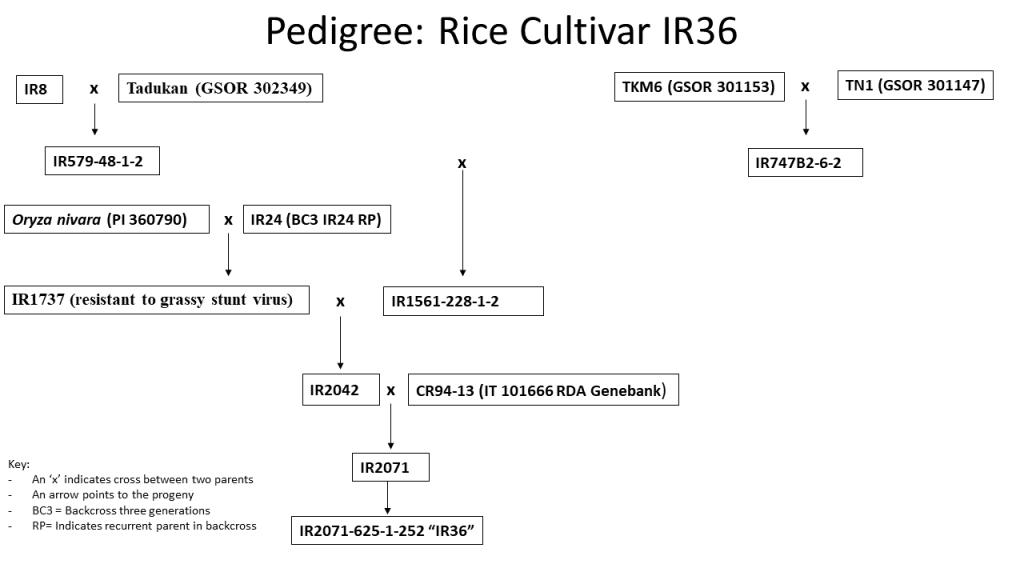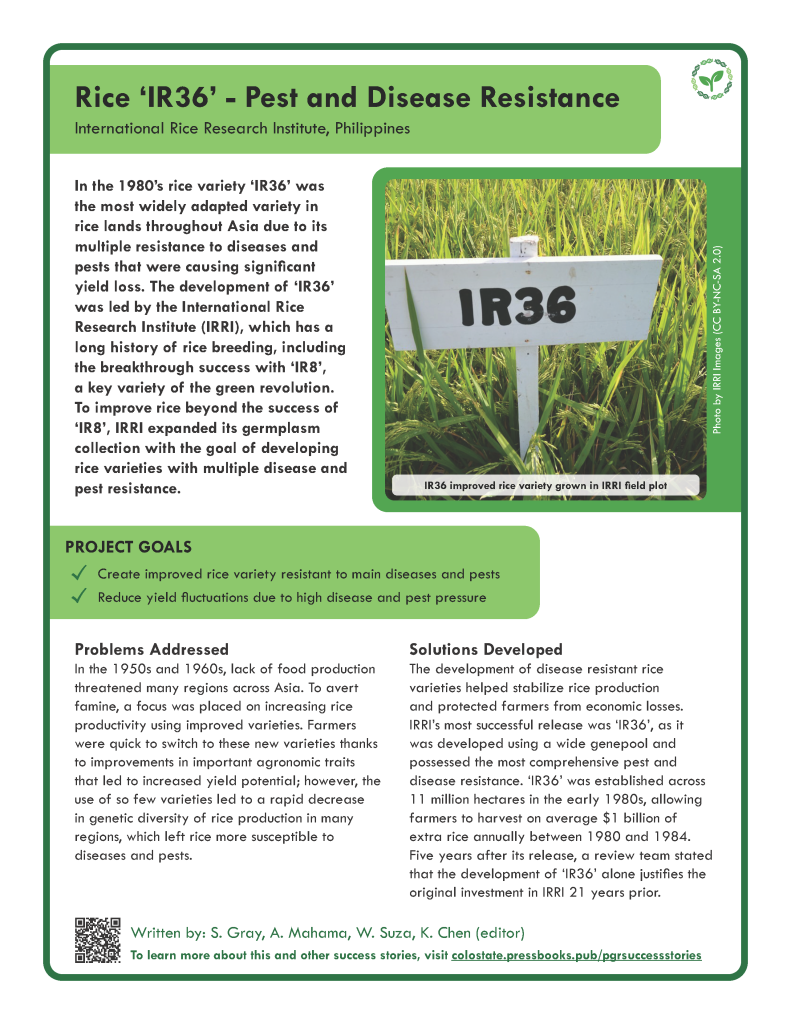Cereals and Pseudocereals
Rice ‘IR36’ – Pest and Disease Resistance
DEVELOPMENT OF RICE (ORYZA SATIVA) VARIETY ‘IR36’ FOR DISEASE AND PEST RESISTANCE
Stephen Gray; Anthony Mahama; and Walter Suza
Department of Agronomy, Iowa State University, Agronomy Hall 716 Farm House Ln, Ames, Iowa 50011.
Corresponding author: sjgray4@iastate.edu
OUTLINE
- Summary
- Problems addressed
- Solutions developed
- Impact
- Germplasm
- References
- Additional resources
- Chapter information
1. SUMMARY

In the 1980’s rice variety ‘IR36’ (Oryza sativa L.) was the most widely adapted variety in rice lands throughout Asia due to multiple resistance to diseases and pests that were causing significant yield loss. The development of IR36 was led by the International Rice Research Institute (IRRI), which has a long history of rice breeding, including the breakthrough success with ‘IR8’, a key variety of the Green Revolution. To improve rice beyond the success of ‘IR8’, IRRI expanded its germplasm collection with the goal of developing rice varieties with multiple disease and pest resistance.
The goal was to develop an improved rice variety resistant to main diseases and pests, and to reduce yield fluctuations due to high disease and pest pressure.
Download a printable fact sheet by clicking the image below.
2. PROBLEMS ADDRESSED
Throughout the 1950’s and 1960’s the threat of famine from lack of food production loomed over many Asian regions. In order to avert famine, a focus was placed on increasing rice productivity through the development of improved rice varieties. After years of research throughout the 1960’s, the newly established International Rice Research Institute (IRRI) released rice variety ‘IR8’. While ‘IR8’ rice performed well in the field compared to historical landrace varieties, it lacked desirable grain characteristics and was susceptible to common diseases and pests. These factors would greatly limit its long-term success.
Many farmers rapidly replaced traditional rice varieties with new improved varieties due to their improvements in important agronomic traits that led to increased yield potential. The most notable of these improvements were reduced lodging and improved response to nitrogen application (Khush, 1987). Eventually the widespread use of improved rice varieties, chiefly ‘IR8’, doubled the yield potential of tropical rice. However, the use of so few varieties led to the rapid decrease in genetic diversity of rice production in many regions. This lack of genetic diversity along with increased cropping intensity left rice more susceptible to a wide array diseases and pests (Khush, 1987). As a result, the yield of improved rice varieties would be dictated by the presence or absence of diseases and pests, and therefore, were wildly inconsistent (Khush, 1987).
3. SOLUTIONS DEVELOPED
The development of disease resistant rice varieties helped stabilize rice production and protected farmers from economic losses. While IRRI gradually released various disease resistant varieties, ‘IR36’ had the most success as it was developed using a wide germplasm pool and possessed the most comprehensive resistance. However, breeding varieties for disease and pest resistance would need to be a priority for future lines as disease and pest resistance tends to break down quickly. Indeed, ‘IR36’ eventually became susceptible to the brown planthopper and diseases transmitted by leafhoppers (Cassman and Dobermann, 2001). ‘IR36’ would prove itself to be valuable not only to farmers, but to IRRI as well. Five years after its release, a review team would note that the development of IR36 alone justifies the original investment at IRRI 21 years prior.
Collaborators involved in developing solution:
- International Rice Research Institute (IRRI), Los Baños, Laguna, Philippines
4. IMPACT
The widespread impact of ‘IR36’ was almost immediately noticeable. A year after its release, ‘IR36’ had replaced ‘IR26’ as the predominant rice variety in the Philippines (Nigel and Donald, 1987). The success of ‘IR36’ led to its rapid establishment across 11 million hectares in the early 1980’s (Khush, 1987). This rapid establishment allowed farmers to harvest an average of $1 billion worth of extra rice annually between 1980 and 1984 (Khush, 1987). This dramatic increase of productivity within such a short time of the release of IR36 highlights the significance of the breeding efforts made by IRRI. Overall, the development of IR36 provided farmers with the ability to stabilize yields by providing multiple disease and pest resistance. Without extensive germplasm collections, adequate germplasm screening, and proper breeding methods, such an increase in productivity would not have been feasible.
5. GERMPLASM
The germplasm used to breed ‘IR36’ was originally sourced from IRRI genebank accessions, crop wild relatives, and important Asian cultivars: ‘IR8’, ‘Taduken’, ‘TKM6’, ‘TN1’, Oryza nivara, and ‘IR24’. Several of these are currently available in the U.S. National Plant Germplasm System: ‘Taduken’ (GSOR 302349), ‘TKM6’ (GSOR 301153), ‘TN1’ (GSOR 301147), and Oryza nivara (PI 360790).

6. REFERENCES
Cassman KG, Dobermann A. 2001. Evolving rice production systems to meet global demand. In Rockwood WG (Ed.). 2001. Rice research and production in the 21st century: symposium honoring Robert F. Chandler, Jr. Los Baños, Philippines. International Rice Research Institute. p. 79-100.
Khush GS. 1987. Rice breeding: Past, present and future. Journal of Genetics 66:195-216. https://doi.org/10.1007/BF02927713
Nigel JH, Donald L. 1987. Gene Banks and the World’s Food. Princeton University Press, Princeton, New Jersey, USA.
7. ADDITIONAL RESOURCES
Hibino H, Usugi T, Omura T, Tsuchizaki T, Shohara K, Iwasaki M. 1985. Rice grassy stunt virus: A planthopper-borne circular filament. Phytopathology 75:894-899. https://doi.org/10.1094/phyto-75-894
Khush GS. 1977. Disease and insect resistance in rice. Advances in Agronomy 29:265-341. https://doi.org/10.1016/S0065-2113(08)60221-7
Khush GS. 1993. Breeding rice for sustainable agricultural systems. In: Buxton DR, Shibles R, Forsberg RA, Blad BL, Asay KH, Paulsen GM, Wilson RF (Eds.) International Crop Science I. Crop Science Society of America, Madison, Wisconsin, USA. https://doi.org/10.2135/1993.internationalcropscience.c31
Khush GS. 2005. IR varieties and their impact. International Rice Research Institute, Los Baños, Philippines.
Plucknett DL, Smith NJH. 1986. Gene banks and the world’s food. Princeton University Press, Princeton, New Jersey, USA.
8. CHAPTER INFORMATION
Citation: Gray S, Mahama A, Suza W. 2022. Rice ‘IR36’ – Pest and Disease Resistance. In: Volk GM, Chen K, Byrne P (Eds.) Plant Genetic Resources: Success Stories. Fort Collins, Colorado: Colorado State University. Date accessed. Available from https://colostate.pressbooks.pub/pgrsuccessstories/chapter/rice-ir36-pest-and-disease-resistance/
Content originally submitted: January 19, 2022
Date of publication: July 2022
USDA is an equal opportunity provider, employer, and lender. Mention of trade names or commercial products in this article is solely for the purpose of providing specific information and does not imply recommendation or endorsement by the U.S. Department of Agriculture.


